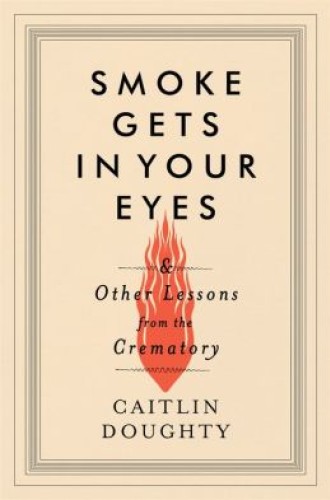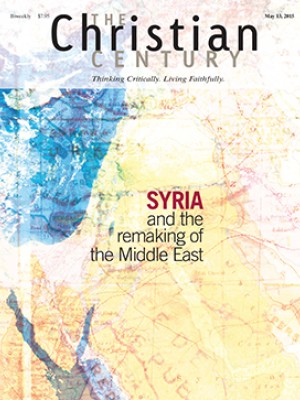Ask a mortician
In the promotional material for Smoke Gets in Your Eyes, we are promised “a peek behind the black curtain,” a revelation of “life’s terrifying secret” by a young woman at work burning dead bodies in California—a high priestess, albeit self-appointed, in the “alternative death” community.
Spoiler alert: we die. There are no alternatives.
Caitlin Doughty belongs to the selfie generation, so she comes by her fascination with her particulars honestly. To be young and female in a crematory enterprise would be special indeed had it not become the norm some time ago. Once a mostly male endeavor, like the Marine Corps and the Rotary Club, funeral work has been feminized. The exception has become the rule.
Read our latest issue or browse back issues.
Likewise, cremations, which accounted for less than 5 percent of body dispositions in 1970, now outnumber burials across a culture that is less grounded, more mobile and portable, more divisible and scattered than ever before. What once involved a two-day wake, a church service with the dead saint situated at the foot of the altar, and a procession to the graveside or tomb, now involves a cell phone, a credit card, industrially efficient incineration, and a bodiless memorial. The dead, Doughty notices, are rarely dealt with or done for by family anymore. They are instead disposed of by “death care professionals,” leaving survivors free to “celebrate life” away from the noisome mortifications of the corpse and the perils of putrefaction.
Doughty asks:
What was a nice girl like me doing in a body-disposal warehouse like this? No one in her right mind would choose a day job as a corpse incinerator over, say, bank teller or kindergarten teacher. And it might have been easier to be hired as a bank teller or kindergarten teacher, so suspicious was the death industry of the twenty-three-year-old woman desperate to join its ranks.
Her self-consciousness owes to her tendency to proclaim an expertise she has not yet achieved, as if cremating bodies leads to enlightenment. Some days it does. Some days it is more heat than light. Some days, indeed, the smoke gets in your eyes.
Though not yet expert, she is a very quick study. Her book, if not a must-read, is a really good one; if not an essential text, no less essentially instructive. Doughty has mined a deep vein of reliable witnesses—literary, secular, classic, and collegial—and adds to their best shots at the big questions her own provisional formulations.
In particular, for the reverend clergy, sage, and seminarian, this is a book well worth the trouble, not only for the blood-and-guts intrigues of the crematory and embalming theater, but for the glimpse it offers of the anxious and unchurched who do not occupy the pews—congregants of the growing parish of the religiously and ritually adrift—who, if they ever ask eternal questions, likely do so when there’s a corpse at hand.
Since witnessing a horrific accident in a shopping mall—a child fell from the second level to her death—Doughty has been obsessed with that vision and its acoustics. “The Thud,” as she calls this formative chapter, can be read as a search for meaning in the senseless event, for a theodicy in the maw of happenstance, mission and calling in the face of sadness. In this she is not unique. But what is peculiar to her generation is the failure of family or community systems to provide paradigms for responding to death—an infrastructure that can bear the weight of mortality. Tabloid grief and Death TV are insufficient. There is no longer a “done thing,” a model for acting out our faith or doubts, grief or gratitude, no humane engagement in the face of mortality.
As the theologian Thomas Long has written, “we have lost our eschatological nerve,” and with it, shared faith in its narrative and comforts. The sinew and vision required for bearing our dead to their dispositions have gone missing with disuse.
Doughty speaks to this dereliction and is willing to try anything to find somewhere to hang her ontological hat. Emboldened by her training in life’s grim realities, she does the heavy lifting, falls into predictably unrequited love, endures an education she does not value, flirts with suicide, opts for life, hooks up with a hitchhiker, and declares enlightenment. Just as many of her parents’ generation believed that they invented sex, Doughty can be forgiven for thinking that she, most authentically, has discovered death—real, undeniable, natural death—and that her calling is to revolutionize the way it is done:
For years, working at Westwind and attending mortuary school, I had been afraid to discuss cultural death denial in public. The Internet is not always the kindest of forums, especially for young women. Tucked away in the comment section of my kitschy web series “Ask a Mortician,” there are enough misogynistic comments to last a lifetime. Yes, gentlemen, I’m aware I give your penis rigor mortis. . . . People in the funeral industry weren’t always thrilled that I was sharing what they perceived to be privileged “behind the black curtain” knowledge. . . . To this day the National Funeral Directors Association, the industry’s largest professional association, won’t comment on me.
What’s a girl got to do to get noticed by the industry? Oughtn’t talk of penises be worth something? We can quibble with the low-grade narcissism, but on the larger matters, Doughty gets it right:
In writing The American Way of Death, Jessica Mitford wasn’t trying to improve our relationship with death, she was trying to improve our relationship with the price point. That is where she went wrong. It was death that the public was being cheated out of by the funeral industry, not money. The realistic interaction with death and the chance to face our own mortality. For all of Mitford’s good intentions, direct cremation has only made the situation worse.
Here Doughty is unpredictably and precisely correct and earns her contrarian stripes. It’s not that morticians charge too much, it’s that they do too much and make it too easy to turn the dead and their dispositions into abstractions.
Of course, most of the mainstream clergy rose to Mitford’s bait and banished the bodies and the boxes from their churches, along with the fierce urgency of the freshly dead and their grief-stricken kin. What remains, decades later, are bodiless obsequies, ubiquitous and abstract “celebrations of life,” convenient, cost-efficient, easy, and meaningless, which emphasize the good laugh over the good cry, personalities over the promises of faith, and hobbies over the heavy lift. Gone, with the corruptible corpse, are the shoulder and shovel work, the holy witness we owe dead saints and sinners, the heft and heave it takes to go the distance with them. The “sacred community theater,” as Long calls it, has been replaced by a light-duty Kabuki roughly equivalent to Calvary without the crucifixion.
Of course, one upshot of banishing the dead from the foot of our altars and sending them on their way alone is that the living have found a way of going it alone religiously as well, each with a custom-made spirituality du jour. If not cafeteria Christianity, then potluck, personalized, do-it-yourself musings and user-friendly hereafters. That’s a bargain compared to belonging, what with its faith claims and commandments, tithes and stipends, sin and sacrifice.
Doughty intends to correct this cultural estrangement. She has a blog, a book, a career, and a cause; a series on YouTube and a knack for candor. She can be Googled, Tweeted, Facebooked, and Instagrammed. It’s all current and cutting edge, Gawker and Jezebel. Still, for all her new-media savvy, her work is the oldest of human endeavors—to deal with the idea of death by dealing with the dead.
Doughty calls unambiguously for us to take up our part in the care of our fellow pilgrims through every station of dying, death, and disposition, whether we burn or bury them or leave them in trees, place them in tombs or cast them into the sea. It is by getting the dead where they need to go that the living get where they need to be.
We can live with grief’s broken heart and apostasy’s shaken faith, but we cannot live with a rotting corpse. Something has to be done with the dead, Doughty tells us expertly, so we might as well try to do it right.






